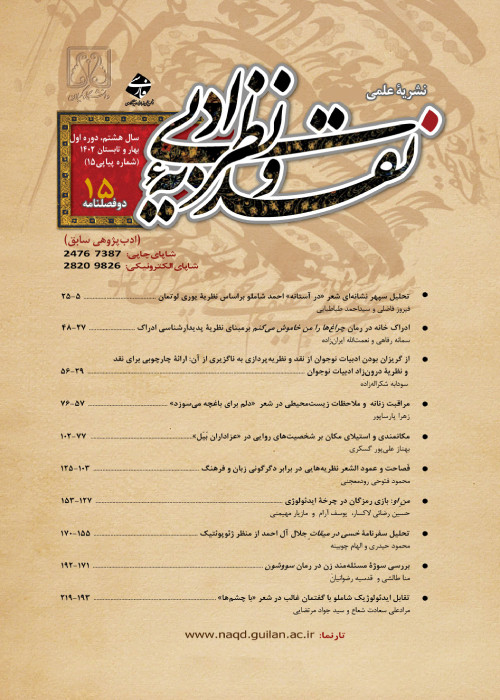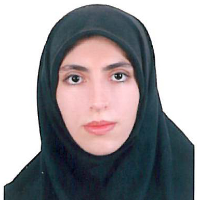Diaspora in Iranian Young Adult Novels: The Experience of Immigration, Liminality and the Marginal Position
Immigration is one of the most familiar notions in the contemporary world, which has changed the lives and narratives of many people. The quality of this experience is quite different for young adults in comparison with the adults. This study examines the representations of immigration and diaspora, and issues related to them, in Iranian young adult novels. As the findings show, forced immigration due to war and insecurity, refuge, exile and transnational immigration are present in Iranian young adult novels. Metaphorically, moving to a world of fantasies can also be seen as a form of immigration. The presence of immigration is sometimes shown through the absence of immigrants; moreover, the effects of immigration on their relatives should be noticed. The Iranian young adult novel has only recently begun to pay attention to diaspora and the multicultural literature. In most of these narratives, the experience of diaspora is tied to war. Immigration inside Iran is more reflected rather than emigration to other countries and turning to multicultural challenges. In these novels, the host society mostly accepts immigrants as an inferior other if they accept the host culture. Young adult diasporic narratives attach particular importance to creating and redefining identity, and show the efforts of immigrants in finding the borders of the self in a new condition. Violence, abandonment, displacement and the challenges of young adult immigrants are represented as well. Extended Abstract1.IntroductionThis study examines the representations of diaspora and issues related to it in Iranian young adult novels. Different kinds of diaspora have been investigated in these novels as well. Diaspora is not a single word or just an event. It includes diverse basic notions. Immigrants not only travel from one place to another, but also travel across cultures, and all material and mental relations of their lives are redefined due to this departure. They need to tie their identity to new things, find a rational relation between homeland and the host country and fix their place in a new land. Clarifying the borders of the self and the other and making an effort to deal with a new culture in the absence of the former identical elements lead to many challenges for immigrants. 2.Theoretical FrameworkYouth is a strong metaphor for moving through cultures and places. In contrast to adults, young adults react in a different way when facing diaspora as they might have different feelings and experiences. On the one hand, their challenges and difficulties seem greater, and on the other, their flexibility, acceptance of the other, being on a border line and having less experience and nostalgia, enable them contact more efficiently with other cultures. The process of adaptation to a new place is associated with constructing a new life and identity. Confusion and the concern with an unconstructed new identity put the immigrant in a threshold situation. In a world in which migration, asylum and displacement due to geographical, political and economic urgencies, as well as the search of a better life, are on the rise, teens need a literature that can oscillate between different cultures, similar to the fluctuation of immigrants between homeland and the host country and the ambivalence of young adults in relation to multiple identities. Young adult literature is of use to diaspora in different aspects. By reflecting the situation, difficulties and possibilities of immigration, diaspora literature, which can be included in the category of multicultural literature, helps young adult immigrants to know their new situation better, to deal with it more appropriately and to know that they are not alone in this experience. In addition, it portrays the feelings, thoughts and difficult condition of immigrants and can arouse the empathy of the host-society’s members and change their views about immigration. This type of literature familiarizes young readers with a new range of experiences and teaches them intercultural dialogue, or at least being tolerant in their encounter with the other. 3.MethodologyUsing a descriptive analytical approach, this article has categorized the types of diaspora in Iranian young adult novels by analyzing all available young adult diasporic narratives. Through classifying the types, the paper discusses the distinction between the approaches of young adult and adult narratives to diaspora. 4.Discussion and AnalysisMost Iranian diasporic narratives are tied to the Iran-Iraq war and can be put in the category of internal migrations. Displacement, loss of home, belongingness and being isolated in the host country due to ethnicity and race are the most dominant themes of these novels. The analysis and interpretations of the novels have been arranged through subtitles like forced immigration due to war and insecurity, refuge, exile, transnational immigration, presence of immigration in the absence of immigrants, gypsies’ diaspora and emigration to a world of fantasies. Migration is a threshold situation and many people may experience it by force or choice. Adolescence is also a threshold situation and trying to stabilize one’s identity and status happens for both teenagers and immigrants similarly. The immigration of adolescents doubles the threshold situation, even though the fluidity of identity facilitates living in a new place for adolescents. Young adult novels reflect identity challenges in the confrontation with the other, and introduce the experiences of immigrants, and the difficulties and possibilities of immigration to young readers. One of the most prominent challenges is how to deal with love. Adolescent relationships usually involve romantic love and sexual attraction. Emotional relationship with someone in a similar condition seems like a haven for teenagers to survive mental health crises and traumas caused by diaspora. 5.ConclusionAlthough multicultural narratives and different types of diaspora, including displacement, transnational diaspora, and refuge have become a common theme in European and American young adult literature in the twenty first century, Iranian young adult novels have only recently begun to pay attention to diaspora and multicultural literature. Immigration inside Iran is more reflected rather than migration to other countries which represent multicultural challenges and the gap between homeland and the host country more deeply and clearly. Translated literature in Persian compensates for the deficiency of diaspora narratives to some extent, but the most common type of diaspora in Iranian young adult literature is internal forced migration due to the Iran-Iraq war. The more recent migrations to Iran from Afghanistan and Pakistan and the increasing emigration of Iranians to other countries have been missed as a trend. In some of the few novels which reflect migration out of Iran, a negative image of leaving the homeland has been presented, and the narratives of several million Iranian emigrants have been ignored in a discursive silence. Representing internal migration during the war has also ideological justification. In this type of migration, displacement, ethnic and racial inequalities, and estrangement make the migrants suffer, so their main concern is to return to the home they have been forced to leave. Iranian young adult literature has reluctantly accepted immigrants to Iran, including Afghans and members of other nationalities. Gypsy travelers, migrants forever, have been marginalized totally and their different life-style has not drawn the attention of writers for young readers. Diaspora studies are new in Iranian children and young adult literature and the present can be a point of departure for broader and even comparative studies in this field. As diaspora narratives form in fluctuation and fusion of the self/other cultures, studies on migration inevitably fluctuate between cultures. Select BibliogrphyAkbarkermaninejad, Ali. 1397 [2018]. Jadou-ye Hezar Parandeh. Tehran: Elmi-Farhangi Publishing Company.Akrami, Jamalodin. 1395 [2016]. Shab be Kheir Torna. Tehran: Institute for the Intellectual Development of Children and Young Adults.Baxter, Kent. 2011. “Immigration Narratives in Young Adult Literature; Crossing Borders.” Children’s Literature Association Quarterly 36/4: 482-484.Clifford, Elizabeth and Maya Kalyanpur. 2011. “Immigration Narratives: Power, Difference, and Representation in Young-Adult Novels with Immigrant Protagonists.” International Journal of Multicultural Education 13/1: 1-20.Hasanzadeh, Farhad. 1389 [2010]. Hasti. Tehran: Institute for the Intellectual Development of Children and Young Adults.Jahangirian, Abbas. 1391 [2012]. Jang keh Tamam Shod Bidaram Kon. Tehran: Ofogh. Kalra, Virinder S., Raminder Kaur and Johan Hutnyk. 2005. Diaspora and Hybridity. London: Sage Publications.Kartiningsih, Rindrah. 2017. “Am I a Christian yet?: A Diasporic Persian Liminality Portrayed in Pary Mansouri’s ‘No, I Was Not Dreaming’.” Proceedings of Literary Studies Conference (LSC5). Universitas Sanata Dharma. 88-90.Khanian, Jamshid. 1389 [2010]. Asheghaneh-ha-ye Yunes dar Shekam-e Mahi. Tehran: Institute for the Intellectual Development of Children and Young Adults.Nel, Philip. 2018. “Migration, Refugees, and Diaspora in Children’s Literature.” Children’s Literature Association Quarterly 43/4: 357-362.
- حق عضویت دریافتی صرف حمایت از نشریات عضو و نگهداری، تکمیل و توسعه مگیران میشود.
- پرداخت حق اشتراک و دانلود مقالات اجازه بازنشر آن در سایر رسانههای چاپی و دیجیتال را به کاربر نمیدهد.



